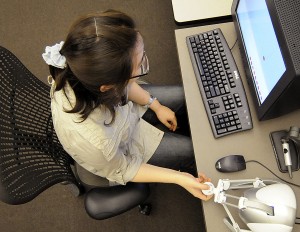Sep 23 2008
Equations or graphs can explain what happens when atoms bump into each other, but a technology called haptics could help students know how it feels. A Purdue University researcher says haptic, or force-feedback, technology can be used in a variety of classroom subjects, especially in the sciences.
 Nanotechnology Education" />Purdue electrical and computer engineering graduate student Min Hee Jun uses a haptic interface to feel interaction forces between two point charges during a demonstration at Purdue's Envision Center for Data Perceptualization. Purdue researchers are working on a National Science Foundation-funded project to develop course modules to incorporate the use of haptic devices in existing sophomore-level courses in the School of Electrical and Computer Engineering. (Purdue News Service photo/Andrew Hancock)
Nanotechnology Education" />Purdue electrical and computer engineering graduate student Min Hee Jun uses a haptic interface to feel interaction forces between two point charges during a demonstration at Purdue's Envision Center for Data Perceptualization. Purdue researchers are working on a National Science Foundation-funded project to develop course modules to incorporate the use of haptic devices in existing sophomore-level courses in the School of Electrical and Computer Engineering. (Purdue News Service photo/Andrew Hancock)
Haptics involves the use of devices, much like joysticks, that allow the user to scan over objects or surfaces and feel the interaction forces. The device measures the position of the tip of the joystick and feeds it to a computer program containing the dimensions of virtual objects, which graphically displays the object on a 3-D monitor. The program uses computer algorithms to calculate the interaction forces between the joystick tip and the virtual objects based on the object's physical properties and feeds that sensation back to the user, just as if the person were touching the objects in real life.
"It's hard to teach these topics when students can't see or feel what they are studying," said Gary Bertoline, associate dean for graduate programs and research in Purdue's College of Technology. "Through various devices that simulate physical properties, haptics allows you to feel things you can't see."
One potential use for haptics is in nanotechnology, where materials are built atom-by-atom or particle-by-particle, too small for the human eye to see without the aid of a high-powered microscope. Currently, undergraduate students typically learn about nanotechnology from textbooks, and usually only graduate students are exploring nanoscale materials in the lab.
Bertoline has recently begun a National Science Foundation-funded project that would develop course modules to incorporate the use of haptic devices in existing sophomore-level courses in the School of Electrical and Computer Engineering.
"We live in a world that functions based on Newton's laws of physics, where, for example, if you drop an object, it will hit the ground unless acted upon by another force. That is something easily demonstrated that students can readily understand," said Bertoline, a distinguished professor of computer graphics technology. "In contrast, nanotechnology is heavily governed by quantum physics, which deals with systems at the atomic level and is much less intuitive and more unpredictable.
"It's tough to explain these concepts without demonstrating them, and we think haptics holds great promise and will go far beyond textbook learning in helping students comprehend and get excited about nanotechnology subjects."
The two-year project is called Enhanced Undergraduate Nanotechnology Education with Haptic and Visualization Tools. Bertoline is working with Ronald Reifenberger, a professor of physics; Deborah Bennett, associate professor of educational studies; and Hong Tan, an associate professor of electrical and computer engineering, all of Purdue.
Tan said students would be able to use the device to move virtual particles or grasp them with tiny tweezers, for example, and be able to sense the force exerted by the particles.
"If you move around a small particle, the force increases as you move closer to another particle, but that's something the human eye can't appreciate," she said. "These devices will hopefully make the physics and equations behind the science easier to imagine."
Over the course of the project, the team will conduct simulations of various actions at the nano-level, perform the calculations of the force exerted by each particle, and create and use computer software that translates the calculations into human sensations.
The Purdue team will then implement the modules into classrooms and test students to measure how well they have learned concepts.
"Studies that already have been done show that using haptic technology in the classroom increases learning retention," Bertoline said. "Many people learn better when they can touch and feel what they are learning, not just read about it."
Bertoline said although this technology is used frequently in industry, it has been in limited use in educational settings, mainly because the cost of the devices has been too high. Recently, devices in the range of $200 apiece have come on the market, which makes the technology more economically feasible for learning.
He predicts that the technology will someday become commonplace in the classroom, especially in STEM disciplines of science, technology, engineering and math.
"Haptics could be used to demonstrate hard versus soft surfaces at the cellular level in biology, which students can't experience under a microscope," he said. "It could be used in most sciences and even could help demonstrate math principles. There are a lot of ways haptics can be used in education."
Bertoline's nanotechnology project is funded through the National Science Foundation's Nanotechnology Undergraduate Education program. The award for $199,259 began on Sept. 1 and runs until August 2010.